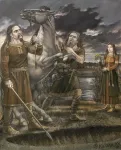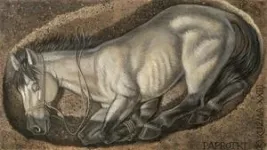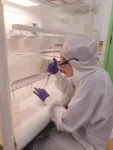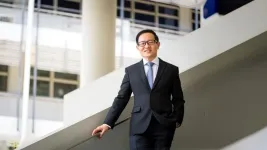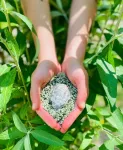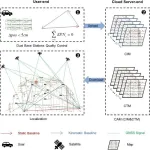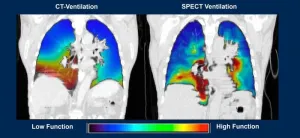(Press-News.org) Horses crossed the Baltic Sea in ships during the Late Viking Age and were sacrificed for funeral rituals, according to research from Cardiff University.
Published in the journal Science Advances, studies on the remains of horses found at ancient burial sites in Russia and Lithuania show that they were brought overseas from Scandinavia utilising expansive trade networks connecting the Viking world with the Byzantine and Arab Empires.
Up to now, researchers had believed sacrificial horses were always locally-sourced stallions. But these results reveal horses from modern Sweden or Finland travelled up to 1,500 km across the Baltic Sea. The findings also show that the sex of the horse was not necessarily a factor in them being chosen for sacrifice, with genetic analysis showing one in three were mares.
A scientific technique called strontium isotope analysis was used on horse teeth from 74 animals to identify where they had originated. Soil, water and plants have a chemical make-up reflecting their underlying geology. The chemical signature is absorbed by animals on consumption and remains locked in the hard enamel of their teeth, allowing archaeologists to trace their life journeys hundreds of years later.
Horse sacrifices were highly visible and symbolic public rites across pagan prehistoric Europe, persisting the latest among the Baltic tribes, up to the 14th century AD. Offering pits might include multiple horses, single complete horses, or partial animals. In many Baltic cemeteries horses were buried separately from humans, but there are numerous examples of horses with overlain human cremations.
Lead author Dr Katherine French, formerly of Cardiff University’s School of History, Archaeology and Religion, now based at Washington State University, said: “This research dismantles previous theories that locally-procured stallions were exclusively selected for sacrifice. Given the unexpected prevalence of mares, we believe the prestige of the animal, coming from afar, was a more important factor in why they were chosen for this rite.
“Viking Age trade routes stretched from modern Iceland, Britain, and Ireland in the West all the way to the Byzantine and Arab Empires in the East. The presence of a trader’s weight in one horse grave points to the key role of horses in these vibrant trade networks.”
Co-author Dr Richard Madgwick, also based at Cardiff University’s School of History, Archaeology and Religion, said: “Pagan Baltic tribes were clearly sourcing horses overseas from their Christian neighbours while simultaneously resisting converting to their religion. This revised understanding of horse sacrifice highlights the dynamic, complex relationship between Pagan and Christian communities at that time.”
This project received funding from the EU Horizon 2020 scheme, Polish Ministry of Science and Higher Education, National Geographic Society, Society for Medieval Archaeology, Alexander von Humboldt Foundation, Deutsche Forschungsgemeinschaft, and Cardiff University.
END
Pagan-Christian trade networks supplied horses from overseas for the last horse sacrifices in Europe
Evidence demonstrates burst of human and animal mobility
2024-05-17
ELSE PRESS RELEASES FROM THIS DATE:
University of Bristol researchers develop world’s smallest quantum light detector on a silicon chip
2024-05-17
Researchers at the University of Bristol have made an important breakthrough in scaling quantum technology by integrating the world’s tiniest quantum light detector onto a silicon chip.
A critical moment in unlocking the information age was when scientists and engineers were first able to miniaturise transistors onto cheap micro-chips in the 1960s.
Now, for the first time, University of Bristol academics have demonstrated the integration of a quantum light detector – smaller than a human hair – onto a silicon chip, moving us one step closer to the age of quantum technologies using light.
Making high performance electronics ...
Gut bacteria boost immune response to fight tumors
2024-05-17
Roughly one in five cancer patients benefits from immunotherapy – a treatment that harnesses the immune system to fight cancer. Such an approach to beating cancer has seen significant success in lung cancer and melanoma, among others. Optimistic about its potential, researchers are exploring strategies to improve immunotherapy for cancers that don’t respond well to the treatment, with the hope of benefiting more patients.
Now, researchers at Washington University School of Medicine in St. Louis have found, in ...
How heatwaves are affecting Arctic phytoplankton
2024-05-17
The basis of the marine food web in the Arctic, the phytoplankton, responds to heatwaves much differently than to constantly elevated temperatures. This has been found by the first targeted experiments on the topic, which were recently conducted at the Alfred Wegener Institute’s AWIPEV Station. The phytoplankton’s behaviour primarily depends on the cooling phases after or between heatwaves, as shown in a study just released in the journal Science Advances.
Heatwaves, which we’ve increasingly seen around the globe in recent years, are also becoming more and ...
NUS scientist Professor Lim Chwee Teck elected Fellow of the Royal Society
2024-05-17
Professor LIM Chwee Teck, Director of the Institute for Health Innovation & Technology at the National University of Singapore (NUS iHealthtech) and NUSS Professor, has been elected to the prestigious Fellowship of the Royal Society, in recognition of his invaluable contributions to science.
The Royal Society is the world's oldest and most esteemed scientific academy in continuous existence, as well as the United Kingdom’s national academy of sciences. Fellows are elected annually, and candidates are evaluated based on their exceptional achievements in science. This ...
Modern plant enzyme partners with surprisingly ancient protein
2024-05-17
UPTON, N.Y. — Scientists from the U.S. Department of Energy’s (DOE) Brookhaven National Laboratory have discovered that a protein responsible for the synthesis of a key plant material evolved much earlier than suspected. This new research explored the origin and evolution of the biochemical machinery that builds lignin, a structural component of plant cell walls with significant impacts on the clean energy industry.
When the first land plants emerged from aquatic environments, they needed to adapt in order to survive.
Chang-Jun Liu, a senior scientist in Brookhaven’s Biology ...
Ion irradiation offers promise for 2D material probing
2024-05-17
Two-dimensional materials such as graphene promise to form the basis of incredibly small and fast technologies, but this requires a detailed understanding of their electronic properties. New research demonstrates that fast electronic processes can be probed by irradiating the materials with ions first.
A collaboration involving researchers at the University of Illinois Urbana-Champaign and the University of Duisburg-Essen has shown that when graphene is irradiated with ions, or electrically charged atoms, the electrons that are ejected ...
Scientists develop new geochemical ‘fingerprint’ to trace contaminants in fertilizer
2024-05-17
DURHAM N.C. – An international team of scientists has uncovered toxic metals in mineral phosphate fertilizers worldwide by using a new tool to identify the spread and impact of such contaminants on soil, water resources, and food supply.
“While mineral phosphate fertilizers are critical to boost global sustainable agriculture and food security, we found high levels of toxic metals in many fertilizers worldwide,” said Avner Vengosh, chair of the Earth and Climate Sciences division at Duke University’s Nicholas School of the Environment. “Our study developed a new method to identify sources and impacts of these metals on the environment.” Those ...
From the road to the cloud: leveraging vehicle GNSS raw data for spatial high-resolution atmospheric mapping and user positioning
2024-05-17
Innovative Global Navigation Satellite System (GNSS) positioning technologies harness massive vehicle-generated data to create high-resolution atmospheric delay correction maps, significantly enhancing Global Positioning System (GPS) accuracy across varied spatial scales. This new method exploits real-time, crowd-sourced vehicle GNSS raw data, refining traditional GPS applications and presenting a cost-effective solution for precise positioning.
The quest for enhanced Global Navigation Satellite System (GNSS) accuracy has been hindered ...
Study suggests that air pollution promotes inflammation in the brain, accelerating cognitive decline and increasing risk of dementia
2024-05-17
Results from new study suggests that long-term exposure to air pollution leads to increased risk in dementia in Denmark.
"We also find association with noise, but this seems to be explained by air pollution primarily. Our study is in line with growing international knowledge on this topic." says Professor at Section of Environmental Health Zorana Jovanovic Andersen.
This is an important finding which adds that air pollution, beyond well-known effects on respiratory and cardiovascular system, also has major impacts on our brain, promoting inflammation in the brain, accelerating cognitive decline, and increasing ...
New imaging software improves lung diagnosis for 30% of patients who can't tolerate contrast dye; has added diagnostic benefits for all patients
2024-05-17
Southfield, Mich., May 17, 2024 – For up to 30% of patients who are allergic to medical contrast dye or have a dye restriction because of other health conditions, they might find that it takes longer to get a diagnosis when it comes to life-threatening lung issues such as pulmonary embolism. That's because imaging methods that detect lung problems but don't use contrast dye aren't as accurate and can be more time-consuming to administer.
Now, new imaging software, developed by pulmonologist Girish Nair, M.D., with Corewell Health William Beaumont University Hospital in Royal Oak, Michigan, and biomedical ...
LAST 30 PRESS RELEASES:
New study shows how the spleen helps the immune system accept a transplant
New Mayo Clinic study advances personalized prostate cancer education with an EHR-integrated AI agent
Researchers identify novel therapeutic target to improve recovery after nerve injury
Microbes in breast milk help populate infant gut microbiomes
Reprogramming immunity to rewrite the story of Type 1 diabetes
New tool narrows the search for ideal material structures
Artificial saliva containing sugarcane protein helps protect the teeth of patients with head and neck cancer
Understanding the role of linear ubiquitination in T-tubule biogenesis
Researchers identify urban atmosphere as primary reservoir of microplastics
World’s oldest arrow poison – 60,000-year-old traces reveal early advanced hunting techniques
Bristol scientists discover early sponges were soft
New study uncovers how rice viruses manipulate plant defenses to protect insect vectors
NSF–DOE Vera C. Rubin Observatory spots record-breaking asteroid in pre-survey observations
Ribosomal engineering creates “super-probiotic” bacteria
This self-powered eye tracker harnesses energy from blinking and is as comfortable as everyday glasses
Adverse prenatal exposures linked to higher rates of mental health issues, brain changes in adolescents
Restoring mitochondria shows promise for treating chronic nerve pain
Nature study identifies a molecular switch that controls transitions between single-celled and multicellular forms
USU chemists' CRISPR discovery could lead to single diagnostic test for COVID, flu, RSV
Early hominins from Morocco reveal an African lineage near the root of Homo sapiens
Small chimps, big risks: What chimps show us about our own behavior
We finally know how the most common types of planets are created
Thirty-year risk of cardiovascular disease among healthy women according to clinical thresholds of lipoprotein(a)
Yoga for opioid withdrawal and autonomic regulation
Gene therapy ‘switch’ may offer non-addictive pain relief
Study shows your genes determine how fast your DNA mutates with age
Common brain parasite can infect your immune cells. Here's why that's probably OK
International experts connect infections and aging through cellular senescence
An AI–DFT integrated framework accelerates materials discovery and design
Twist to reshape, shift to transform: Bilayer structure enables multifunctional imaging
[Press-News.org] Pagan-Christian trade networks supplied horses from overseas for the last horse sacrifices in EuropeEvidence demonstrates burst of human and animal mobility
